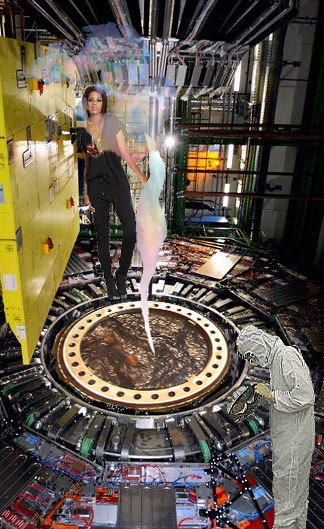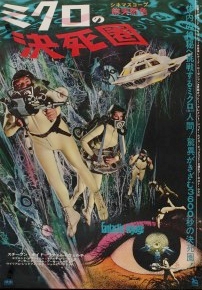For millions of years the Huaoshy made use of sedrons for the operation of spacecraft that could move through space at faster-than light speeds.
During this time, the Huaoshy had a primitive teleportation technology that only allowed the transport of simple materials such as a mass of a pure element and nothing more complex than a volume of water.
When the Huoashy finally achieved a complete understanding of the material constituents of the universe, they were able to fully develop their teleportation technology. A serious limitation on teleportation is that it relies on sophisticated transmitters and receivers. Thus, the Huaoshy continue to rely on spaceships for the exploration of new galaxies while making use of teleportation to facilitate their movement to worlds that have already been visited by their spacecraft and where teleportation receivers have been constructed.
In the Contact television series, humans are provided with instructions for how to make a teleportation receiver. The first two receivers built are the IPV transport “drop pods” that only function within the Machines. After the “message from Vega” is terminated, those first two receivers can no longer function. With the help of an Interventionist, Kate Robinson constructs a teleportation receiver that allows her to observe newly arrived nanites that have been teleported to Earth.
Giants have frequently been the subject of fantastic stories. By the time that Voltaire wrote Micromegas astronomers were mostly convinced that stars were distant sun-like objects. Why not imagine gigantic aliens from some distant planet? In some ways, discovery of the very small was more challenging than coming to appreciate of the very large. Humans have always been able to observe our galaxy by naked eye astronomy….it was just a matter of understanding what could be seen in the night sky. Recognition of cells and molecules required special devices such as microscopes. Sometime in the 1970s I saw Fantastic Voyage on television. The idea of shrinking and enlarging objects like people has been a strange topic within science fiction.
In the first edition of Amazing Stories there was a story called “The Man from the Atom“. In this story, it is found that what we know as our universe is like a tiny particle within a much larger overuniverse. This was discovered following the invention of a nuclear-powered device that allowed a person to be enlarged to the size of the universe. When I was young other kids would sometimes want to discuss the idea that individual atoms in our bodies might actually be planets with very small lifeforms living on them. This kind of world-within-world was incorporated into the Men in Black movie.
Faster-than-light travel, mental telepathy, super small or super large people….all these kinds of science fiction plot devices provoke me to want to invent new and imaginary science that could “explain” what seems impossible within the confines of currently known scientific ideas. Why bother? Why not just assume that such things are possible and then have fun imagining stories that use these plot devices?
For me, there is an important boundary between fantasy and science fiction. In fantasy, you can write about giants and never have to think about the practicalities of very large biological organisms. I can’t stop my mind from asking questions such as, “Is that really possible? How would that work? If you can do that, then what else is possible?”
The first space opera that I read was stories like “Skylark Three” by E. E. Smith. I was vastly amused by Smith’s solution to the problem of finding a way to travel between distant galaxies in a reasonable amount of time: make a spaceship engine that allows you to travel at the speed of thought. I was frustrated by Asimov’s hyperspace jumps. The first jump is 1,000,000 parsecs, but then during the 20,000 years during which humans spread through the galaxy we hear nothing about travel to other galaxies.
 For me, a major benefit of depicting technology in science fiction as being firmly rooted in imagined science is that we discover some constraints on the technology. Here are some examples of constraints on SciFi rechnology: 1) in Fantastic Voyage you could shrink people but after a while they would automatically return to normal size. 2) in The Man from the Atom time slowed down at larger size scales. I’m not happy when there is no imaginary scientific explanation for these constraints. You might as well just give up and call it fantasy. For the intergalactic travel technology of the Huaoshy, I imagine that there is a fundamental constraint imposed by information processing, that a description of the structure of a teleported object must be generated and transmitted through the type of “hyperspace” that is included in the Exodemic Fictional Universe. The vast amount of data required can only be stored by “array sedrons“. The fact that the Huaoshy have engineered a monopoly on sedrons means that they can control exactly who is allowed to use teleportation technology.
For me, a major benefit of depicting technology in science fiction as being firmly rooted in imagined science is that we discover some constraints on the technology. Here are some examples of constraints on SciFi rechnology: 1) in Fantastic Voyage you could shrink people but after a while they would automatically return to normal size. 2) in The Man from the Atom time slowed down at larger size scales. I’m not happy when there is no imaginary scientific explanation for these constraints. You might as well just give up and call it fantasy. For the intergalactic travel technology of the Huaoshy, I imagine that there is a fundamental constraint imposed by information processing, that a description of the structure of a teleported object must be generated and transmitted through the type of “hyperspace” that is included in the Exodemic Fictional Universe. The vast amount of data required can only be stored by “array sedrons“. The fact that the Huaoshy have engineered a monopoly on sedrons means that they can control exactly who is allowed to use teleportation technology.
The other benefit from creating imagined science for the Exodemic Fictional Universe is that, for me, discovery is much of the fun in science fiction. I’ve always enjoyed fictional accounts of scientific discoveries and technological breakthroughs. My favorite Sci Fi stories not only show imagined technology being used, but also there is some attention paid to the process by which new scientific discoveries are made. In terms of the social side of science fiction I have fun imagining how cultures change when new technologies become available.
If advanced technology (such as intergalactic teleportation) seems like magic to us, then I take it as a challenge to imagine a story in which a character can start out not even knowing that teleportation is possible but by the end of the story the magic has been replace by understanding of the teleportation technology and use of teleportation is taken for granted.
The other fun type of exodemic story is more frustrating for the protagonist. Evidence for an advanced technology is obtained, but then there is no obvious way to make use of that technology. If a bottle falling out of the sky can create a mystery, then so can stumbling upon an abandoned piece of alien technology. For example, in The Search for Kalid, humans are trying to learn how to make use of abandoned alien teleportation devices, but they have no significant knowledge of how hierions and sedrons provide the scientific basis of teleportation. It might take a trilogy to get all the way to intergalactic teleportation in The Search for Kalid.
The first novel in the trilogy is mostly complete, but new collaborating authors are welcome.




Leave a comment